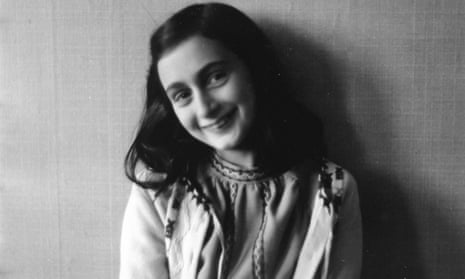A younger, lighter version of Anne Frank – a little girl with braces, who doesn’t want to have her hair cut and who has “no lack of companionship as far as boys are concerned” – has been revealed for the first time in English, through a series of previously unpublished letters written to her grandmother.
Part of the forthcoming Anne Frank: The Collected Works, the letters have never been published in full, or in English, before. They were written between 1936 and 1941, before Anne began the diary she kept from her 13th birthday on 12 June 1942, until the moment just over two years later when the Nazis raided the secret annexe where she had been living in hiding with her family.
In a letter believed to date to spring 1941, Anne writes to her grandmother of how “I have pretty long hair … Papa and Mama want me to get it cut but I’d much rather let it grow”. She also confides that “I have a little appliance in my mouth, and braces … Now I have to go to the dentist every week, and it comes out the next day. This has been going on for eight weeks, and I find it very unpleasant, of course.”
Later that year, she tells her grandmother of the birthday presents she has received: “From Papa and Mama a bicycle, a new school bag, a beach dress and various other things.
“Margot gave me this stationery, because I had run out, and I didn’t do too badly on candies and other little presents either. It’s very warm here, is it warm there too? I really appreciated Stephan’s poem. I also got one from Papa, but that’s to be expected,” she writes. “Yesterday (Sunday) I went out with Sanne, Hanneli and a boy. It was lots of fun, I have no lack of companionship as far as boys are concerned.”
But the Netherlands had been invaded by the Germans on 10 May 1940, and Jews were being persecuted. Elements of how her life was already changing found their way into the letters. “Jewish lessons have stopped for the time being,” she writes in 1941. “I’m getting a new dress, it’s very hard to get fabric, and it takes lots and lots of ration coupons.”
In another letter, she tells her grandmother that “I wish I could start ice skating again, but I’ll just have to have a little more patience, until the war is over … If Papa can still afford it I’ll get figure-skating lessons again, and when I can skate really well Papa has promised me a trip to Switzerland, to see all of you.”
Out on 30 May from Bloomsbury, Anne Frank: The Collected Works brings together all three versions of Anne’s landmark diary, along with essays, photographs, letters and notebooks of her favourite quotes, and contextualising essays from writers including Francine Prose and the historian Gerhard Hirschfeld.
“It’s important to understand where this girl was coming from,” said Yves Kugelmann from the Anne Frank Fonds. “A lot of people only know the diary, and knowing the diary without understanding her family life story and her environment doesn’t give the same message.”
The letters, added Kugelmann, give an insight into the informal, chatty tone Anne adopts in her diary, which has sold more than 30m copies around the world. “Where is her tradition of writing coming from? It isn’t falling from heaven, it’s coming from a kind of culture,” he said. “I think the idea of writing the diary comes from her own writing before she was in hiding. She and her family were always writing letters to each other.”
Anne’s letters to her grandmother, Alice Frank, would have been seminal, he added. “Anne is very close to her and a lot of mentalities in Anne’s character are coming from Alice,” he said. “This was a family with strong women characters: you can see this in the letters she’s writing.”
The collected works, said Kugelmann, will give a more rounded version of Anne to the world. “I think most people know Anne from the diary without the context of the family, her socialisation, where she was educated, where she was in an environment of culture. With this book the reader gets a lot more [of the] context of her narrative: of her culture, of her Jewish family life and of her roots.”
